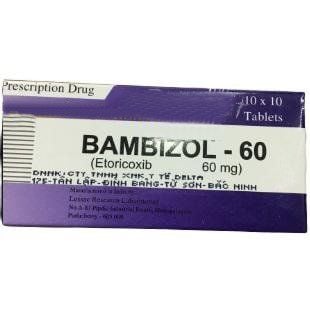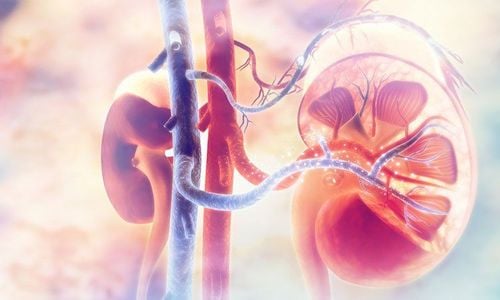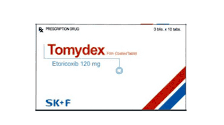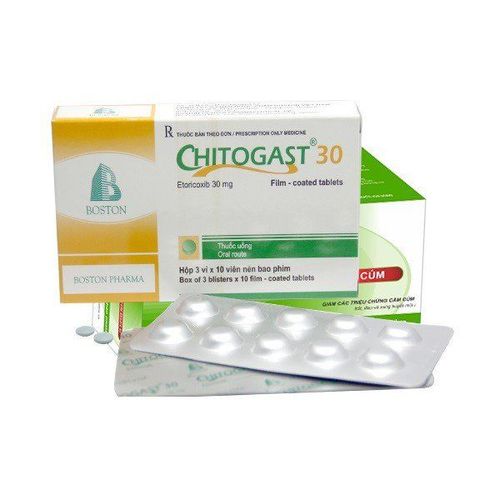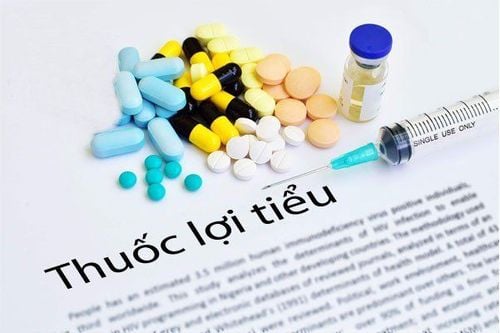This is an automatically translated article.
Celosti is an anti-inflammatory pain reliever that is used to treat pain caused by inflammation. Celosti has a lower risk of gastrointestinal side effects, so it may be safer for people with a history of stomach problems.1. Effects of Celosti
Celosti contains the active ingredient Celecoxib 200mg. This is a non-steroidal anti-inflammatory drug (NSAID).Mechanism of action of Celecoxib: This is a selective inhibitor of the enzyme cyclooxygenase-2 (COX-2). This is the enzyme that catalyzes the production of chemical mediators that cause the inflammatory response. Since then, it has anti-inflammatory, pain-relieving, fever-reducing effects. Celecoxib inhibits prostaglandin synthesis, primarily through inhibition of COX-2 and reduction of prostaglandin precursor formation. Because the drug does not have a COX-1 inhibitory effect, celecoxib has a low risk of adverse effects on the gastric mucosa and anti-platelet aggregation.
Celosti 200 is indicated for use in the following cases:
Treatment helps relieve symptoms of degenerative joint disease, rheumatoid arthritis. Adjunctive treatment for the relief of signs and symptoms of juvenile idiopathic arthritis in patients 2 years of age and older and weighing at least 10 kg. Treatment of the symptoms of ankylosing spondylitis. Pain relief in primary dysmenorrhea.
2. When is Celosti contraindicated?
Celosti 200 is contraindicated for use in the following cases:There is a history of hypersensitivity to the drug Celecoxib or any of its ingredients. There is a history of hypersensitivity to sulfonamides. Use caution in asthma, other allergic-type reactions after taking aspirin or other non-steroidal anti-inflammatory drugs. Not for use in the treatment of pain during coronary artery bypass grafting (CABG).
3. Usage and dosage of Celosti
3.1. How to take Celosti
The drug is taken orally, if it is difficult to drink, you can mix the powder inside the capsule and drink it with water or eat with food. Should be used after meals.3.3. Dosage
Adults Symptomatic treatment in osteoarthritis: 200mg as a single dose or 100mg twice daily. Treatment of rheumatoid arthritis: 100mg or 200mg, twice daily. Ankylosing spondylitis: 200mg once or 100mg twice daily. Some patients may need to take a total daily dose of 400mg. Management of acute pain: Initial dose is 400 mg, an additional 200 mg dose may be given on the first day if necessary. On subsequent days, it is recommended to take 200mg twice daily as needed. Treatment of primary dysmenorrhea: Initial dose of 400mg, an additional dose of 200mg on the first day if pain occurs. On subsequent days, 200mg twice daily is recommended if pain is present. For those with poor CYP2C9 metabolisers: Celecoxib should be used with caution. Start with a therapeutic dose equal to 1/2 of the lowest recommended dose. Use in combination with Fluconazole: Should be used with 1/2 recommended dose. Children 2 years and older Juvenile idiopathic arthritis: From 10kg to 25kg: 50mg, twice daily. Over 25kg: 100mg, 2 times a day. Elderly: Over 65 years of age no dose adjustment is required. For the elderly, if less than 50 kg, the lowest recommended dose should be used at the beginning of the course of treatment. Hepatic impairment: No dose adjustment is required in patients with mild hepatic impairment. Administer 1/2 the normal dose in patients with moderate hepatic impairment. There are no adequate studies in patients with severe hepatic impairment. Renal impairment: No dose adjustment is required in patients with mild to moderate renal impairment. There are no adequate studies in patients with severe renal impairment.4. Possible side effects when taking Celosti
In general, if the drug is used in usual doses and for a short time, Celecoxib is well tolerated, with little risk of side effects.When taking the drug can cause some of the following side effects:.
Common side effects:
Digestion: Abdominal pain, diarrhea, slow digestion, flatulence, nausea. Respiratory: Pharyngitis, rhinitis, sinusitis, risk of upper respiratory tract infection. Central nervous system: Insomnia, trouble sleeping, dizziness, headache. Skin: Skin rash Back pain, causing peripheral edema. Rare side effects:
Cardiovascular: Syncope, can cause congestive heart failure, ventricular fibrillation, pulmonary embolism, risk of cerebrovascular accident, peripheral embolism, thrombophlebitis, vasculitis. Gastrointestinal: Intestinal obstruction, gastrointestinal perforation, gastrointestinal bleeding, hemorrhagic colitis, esophageal perforation, pancreatitis. Hepatobiliary: Gallstone disease, jaundice, hepatitis, liver failure. Hematology: Thrombocytopenia, agranulocytosis or reduction, non-regenerative anemia, pancytopenia. Reduce blood glucose. Central Nervous System: Nervous system ataxia, delusions causing suicidal actions. Renal: Acute renal failure, interstitial nephritis. Skin: Erythema multiforme, exfoliative dermatitis, Stevens - Johnson syndrome. Anaphylactic reactions, angioedema. If there is evidence of kidney damage such as oliguria or edema during treatment, it is necessary to discontinue the drug, usually renal function will return to the pre-treatment level after stopping the drug.
If there are serious unwanted effects such as anaphylaxis, excessive skin reactions, ... need to stop the drug and go to a medical facility for timely treatment.
5. Notes when using Celosti
When using the drug, the following should be noted:Before use, it is necessary to inform the history of drug allergies, accompanying medical history and drugs being used. Caution when used for the following subjects: People with a history of peptic ulcer, gastrointestinal bleeding; history of asthma, allergy to aspirin or a non-steroidal anti-inflammatory drug due to the risk of anaphylaxis. Elderly people and people with weakened bodies because they easily cause gastrointestinal bleeding and often kidney function will decline due to age. Celecoxib can cause nephrotoxicity in people at high risk such as heart failure, kidney failure, liver failure. People with edema, water retention because the drug causes fluid retention. People with extracellular water loss (due to taking strong diuretics) need to be careful when using. Pregnancy: There are no studies in pregnant women. As with other prostaglandin synthesis inhibitors, which can also cause decreased uterine contractility and premature closure of the aortic duct in the fetus, use of Celecoxib should be avoided during the third trimester of pregnancy. It should only be used when the potential benefit to the mother outweighs the potential risk to the fetus. Lactation: Very little amounts of Celecoxib are excreted in breast milk. But because celecoxib can have very serious side effects in nursing infants, consideration should be given to stopping breastfeeding while taking the drug. Overdose can occur when the drug is taken at too high a dose. With manifestations like other non-steroidal anti-inflammatory drugs, such as lethargy, drowsiness, nausea, vomiting, epigastric pain; These manifestations are usually reversible with symptomatic treatment. Rarer manifestations are hypertension, acute renal failure, respiratory depression and coma. Anaphylactoid reactions have also been reported in possible overdose. The patient should be taken to a medical facility for prompt treatment. Drug interactions can occur when this drug is taken with other drugs. Therefore, you need to be careful when using this medicine with other drugs. This drug should not be used for a long time because it has a risk of cardiovascular disease, kidney disease, ... only used as directed by a doctor. Do not use when there are signs of damage and expiry date. Above is information about the uses of Celosti and how to use it. You should consult your doctor when taking micro drugs may not be suitable for many people and the risk of unwanted side effects.
Please dial HOTLINE for more information or register for an appointment HERE. Download MyVinmec app to make appointments faster and to manage your bookings easily.




